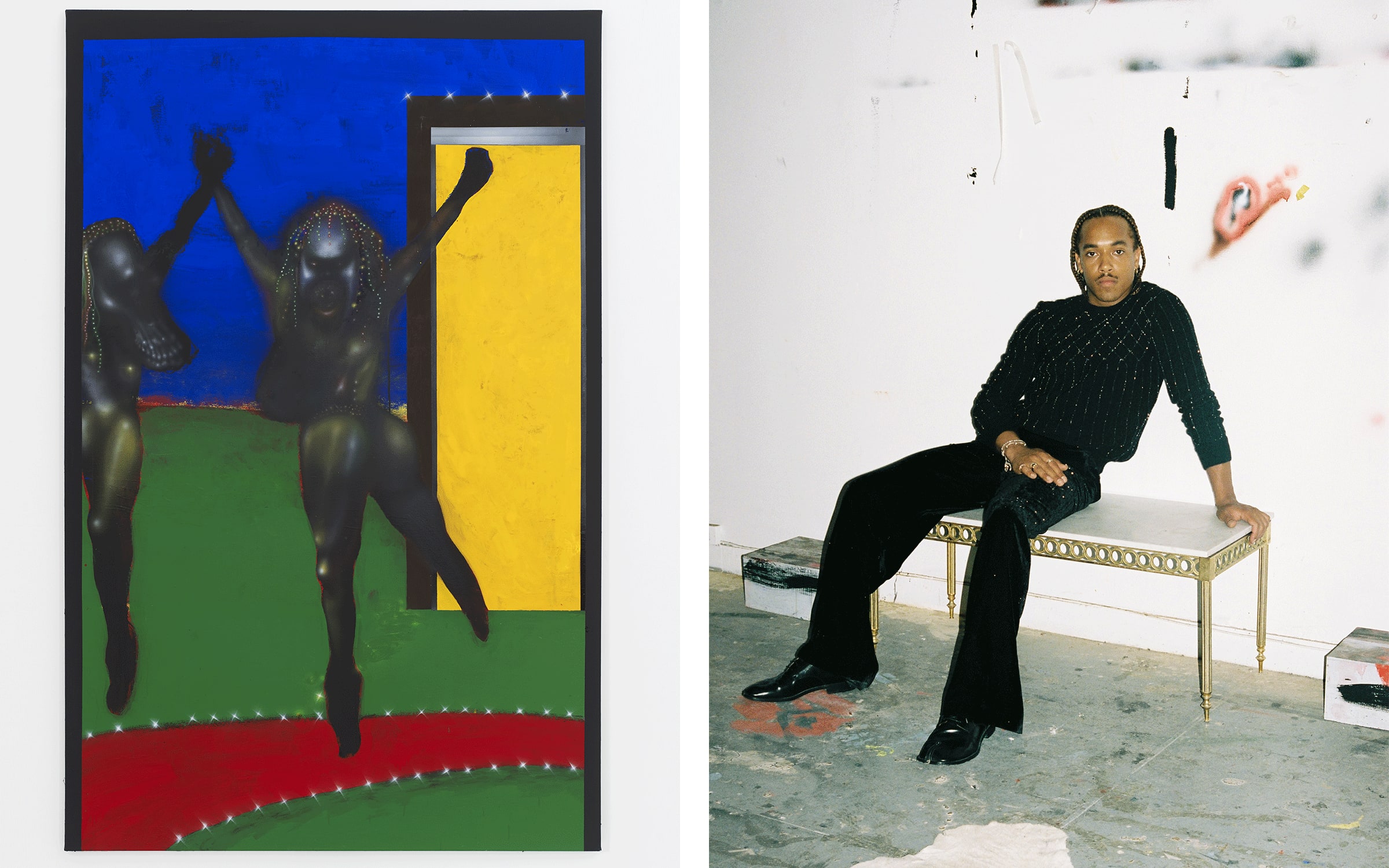Pol Taburet depicts moments of desire, fear, and threat. His characters, caught in moments of intimacy, call out to us, making of us either witnesses or intruders. Parade (2022) is part of a diptych with Out of the Womb (2022), created for the Dhaka Art Summit 2023, which was articulated around the character of Bonna – both a name and the word for flood in Bengali – and centered on the theme of climate change. Taburet’s work illustrates his fascination for the stories, objects, and figures – both human and animal – that bring tangible, spiritual, and fantasized worlds into contact with one another.

Parade is the image of an encounter: two Black figures, one of which is already halfway off the canvas, move with arms raised, hand in hand, toward a point outside the frame. The landscape that surrounds them is composed of four elements: an ultramarine sky; a grass-green field stretching toward the horizon which is intersected by a blood-red path – like a Hollywood red carpet – with tiny lights running along the edges; and a door-like aperture filled with an expanse of bright yellow. The landscape is unusual and mysterious.
The work was born from a memory of a scene in Marcel Camus’s musical film Orfeu Negro, which was awarded the Palme d’Or at the Cannes Film Festival in 1959 and transposes the Greek myth of Orpheus and Eurydice to the Brazilian context of Rio de Janeiro during Carnaval. The euphoria and colors of the festivities, the rhythm of the bossa nova, the dances, and the boundless love of the ill-fated couple are all present in Taburet’s work. The two female bodies appear to be dancing in exaltation, their hair styled with colorful, glittering adornments, and their faces seemingly masked as though they are on their way to a ceremony or a ritual.

In the myth, when Orpheus goes to the underworld to save Eurydice and bring her back with him to the world of the living, it is on condition that he does not look at her, or else he will lose her forever. In this context, the two figures in Parade appear doomed to irreparable separation: situated in two different spaces on the canvas, they belong to two different worlds. The play of gazes becomes an essential agent in the dramatic action: while the central figure looks directly at us, the figure on the left looks at her, like Orpheus who cannot keep from admiring Eurydice, thereby precipitating their eternal separation.
The landscape thus becomes the underworld: the central figure, balanced on her left foot, seems to be burning herself as she attempts to cross the River Styx, while her right foot is erased, as if by metamorphosis. But is the character leaving the underworld or entering it? At the threshold of two worlds, these figures symbolize life and death – a pairing that Taburet featured in several paintings in 2022. Conspiratorial partners and joyful lovers, these two tenebrous powers that set the universe in motion, in things both seen and unseen, are here portrayed at a tipping point – perhaps of their union, or perhaps of their eternal separation.
Pol Taburet is represented by Balice Hertling (Paris) and Mendes Wood DM (São Paulo, Brussels, New York).
Pol Taburet
‘OPERA III : ZOO “The Day of Heaven and Hell”’
Lafayette Anticipations – Fondation Galeries Lafayette, Paris
Until September 3, 2023
Elsa Coustou is Curator and Public Program Coordinator at Lafayette Anticipations – Fondation Galeries Lafayette, Paris.
English translation: Jacob Bromberg.
Published on June 21, 2023.
Caption for full-bleed images, from top to bottom: 1. Pol Taburet, Parade, 2022. © Courtesy of the artist & Mendes Wood DM. Photograph by Kristien Daem. 2. Pol Taburet, Jumping out the womb like my daddy is the devil, 2022. © Courtesy of the artist and Balice Hertling, Paris. Photograph by Jiayun Deng. 3. Pol Taburet, Götterspeise, 2021. © Courtesy of the artist, Balice Hertling, Paris and C L E A R I N G, New York/Brussels. Photograph by Martin Elder.